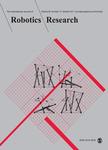版权所有:内蒙古大学图书馆 技术提供:维普资讯• 智图
内蒙古自治区呼和浩特市赛罕区大学西街235号 邮编: 010021

作者机构:Univ Illinois Dept Comp Sci Urbana IL 61801 USA Iowa State Univ Dept Comp Sci Ames IA 50011 USA
出 版 物:《INTERNATIONAL JOURNAL OF ROBOTICS RESEARCH》 (国际机器人研究杂志)
年 卷 期:2004年第23卷第1期
页 面:3-26页
核心收录:
学科分类:12[管理学] 1201[管理学-管理科学与工程(可授管理学、工学学位)] 08[工学] 0811[工学-控制科学与工程]
主 题:sensor-based planning visibility pursuit-evasion on-line algorithms surveillance bug algorithms sensing uncertainty
摘 要:We address an on-line version of the visibility-based pursuit-evasion problem. We take a minimalist approach in modeling the capabilities of a pursuer robot. A point pursuer moves in an unknown, simply-connected, piecewise-smooth planar environment, and is given the task of locating any unpredictable, moving evaders that have unbounded speed. The evaders are assumed to be points that move continuously. To solve the problem, the pursuer must for each target have an unobstructed view of it at some time during execution. The pursuer is equipped with a range sensor that measures the direction of depth discontinuities, but cannot provide precise depth measurements. All pursuer control is specified either in terms of this sensor or wall-following movements. The pursuer does not have localization capability or perfect control. We present a complete algorithm that enables the limited pursuer to clear the same environments that a pursuer with a complete map, perfect localization, and perfect control can clear (under certain general position assumptions). Theoretical guarantees that the evaders will be found are provided. The resulting algorithm to compute this strategy has been implemented in simulation. Results arc shown for several examples. The approach is efficient and simple enough to be useful towards the development of real robot systems that perform visual searching.